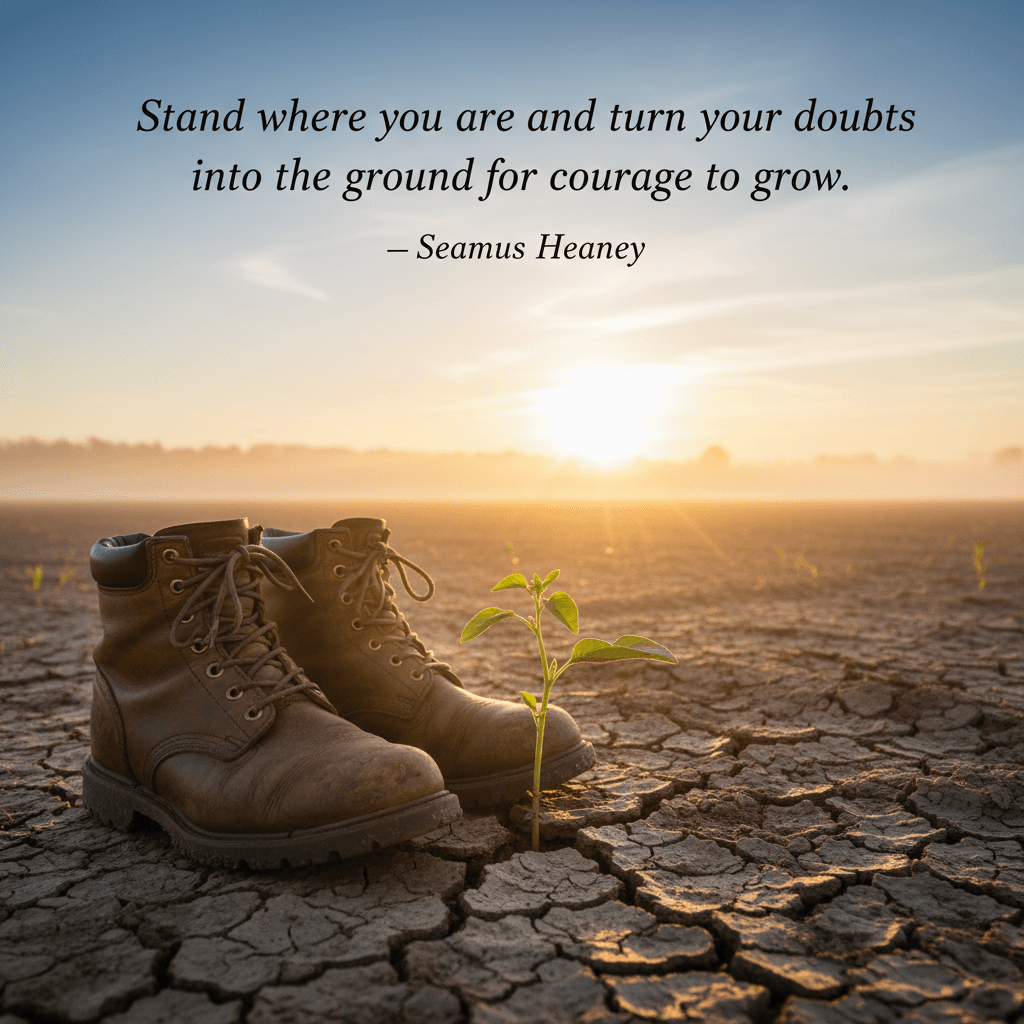Rooting Doubt to Grow Everyday Courage

Stand where you are and turn your doubts into the ground for courage to grow. — Seamus Heaney
Standing Still as a Beginning
Heaney’s imperative to “stand where you are” reframes courage as composure before motion. Instead of scrambling for escape or certainty, he invites a pause that gathers scattered attention back into the body—feet planted, breath steady, gaze clear. This stillness is not passivity; it is orientation. By refusing to flinch, we see the lay of the land and name what is actually there. From that steadied stance, fear stops being a blur and becomes legible. Doubts cease to chase us from behind and line up in front of us like terrain features on a map. Only then can we work with them rather than be worked over by them.
Turning Doubt into Fertile Ground
The line’s core alchemy is agricultural: doubt becomes soil, not waste. Composting unease into nourishment echoes what psychologists call cognitive reappraisal—shifting the meaning of an emotion so it serves rather than sabotages. Carol Dweck’s research on growth mindset (2006) shows that seeing difficulty as feedback, not verdict, predicts resilience. Likewise, Alison Wood Brooks (2014) found that recasting anxiety as excitement measurably improves performance. Thus, the flutter in the gut is not an alarm to flee but a seedbed for readiness. When uncertainty is tilled rather than denied, it releases energy we can direct toward the next right action.
Heaney’s Earth Imagery and Resolve
Heaney often turns to ground as moral vocabulary. In “Digging” (1966), he aligns the heft of a spade with the heft of a pen, rooting craft in ancestry and effort. “Bogland” (1969) and “The Tollund Man” (Wintering Out, 1972) press into peat’s depths, where memory and history preserve what surface life forgets. The terrain is literal, but it is also ethical: depth requires patience, and patience breeds courage. Later, “The Cure at Troy” (1990) offers his most cited hope—when “hope and history rhyme”—suggesting that steadfast attention can ripen into change. Doubt, then, is not erased but metabolized, like earth taking seed.
Practices that Anchor Courage
To till doubt into courage, begin with the body: the 5–4–3–2–1 grounding exercise anchors attention to five sights, four sounds, three touches, two smells, one taste. Next, write two columns: Doubts and Uses. Turn each doubt into a task (“I might freeze” becomes “I will rehearse my first sentence twice”). Then set one micro-commitment—90 seconds of focused effort—to break inertia. Implementation intentions also help: “If I feel my voice shake, then I’ll slow my exhale to six counts” (Gollwitzer, 1999). Finally, carry a talismanic routine—sharpen a pencil, lace shoes the same way—so the body remembers steadiness even when the mind forgets.
From Personal Firmness to Collective Bravery
Standing one’s ground scales from private steadiness to public stance. During the Troubles, Heaney’s “Whatever You Say Say Nothing” (North, 1975) records the pressure to keep quiet; yet the poem’s integrity models a way to stay present without surrendering truth. His Nobel lecture, “Crediting Poetry” (1995), argues for the redress of poetry—language weighting reality with just measures. In this light, courage is not swagger but witness. When individuals root their doubts and speak from that groundedness, communities find a center of gravity sturdy enough to change the weather of a room, a meeting, even a moment in history.
A Small Story of Reframed Fear
Consider a junior nurse on her first night shift. Her hands tremble as alarms flicker. She writes three doubts on a scrap—too slow, not enough, will falter—then turns each into ground: slow means double-check; not enough means ask; will falter means call for backup early. Between rounds, she practices one slow exhale at each doorway. By dawn, nothing miraculous has happened—only charts filled, calls made, a patient comforted. Yet she recognizes it: the place where her doubts were planted now holds roots. The ground did not change; her footing did.
Choosing the Right Ground
To be clear, “stand where you are” is not a command to endure harm. Good gardeners sometimes transplant. If the soil is toxic—abuse, illegality, corrosive cynicism—courage may mean stepping to safer ground and then standing. The point is not stubbornness but rootedness. Consequently, the practice becomes a cycle: stand, name, till, seed, step. Repeat as needed. Over time, the very doubts that once scattered you become the mulch that holds your courage in place.